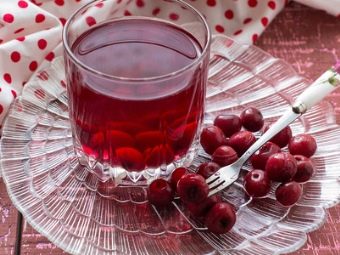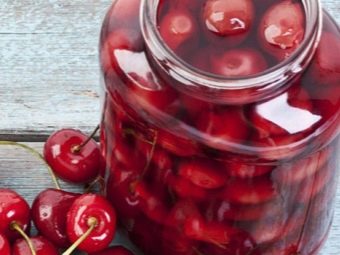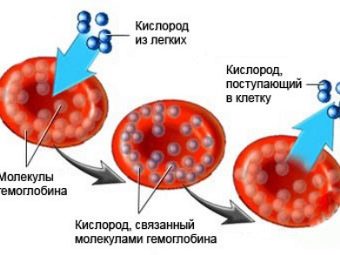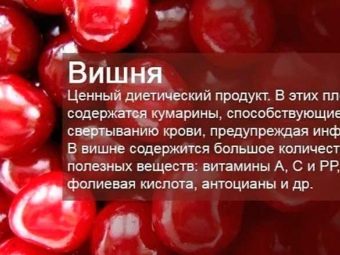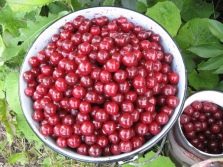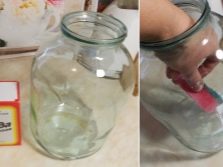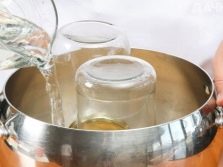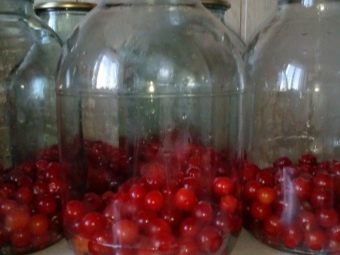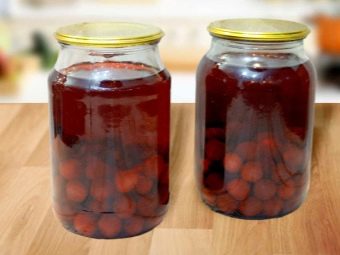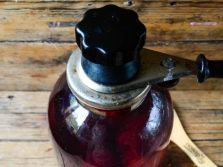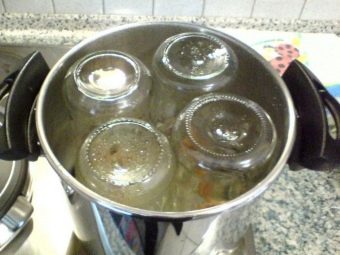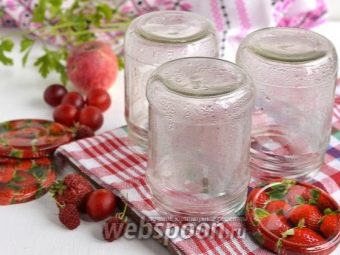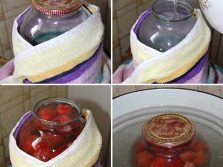How to make cherry compote for the winter?
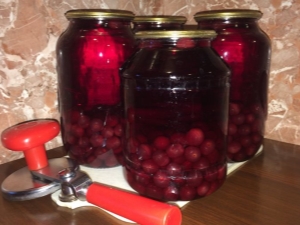
To prepare 2-3 cans of cherry compote for the winter can be done even by a young housewife.Despite the fact that this is an extremely fascinating process, it still requires seriousness and responsibility, since it is necessary to select and prepare the berries correctly, strictly follow the algorithm of actions for conservation. You can read more about them and find out what the benefits and popularity of this drink are in this article.
Calorie and composition
The calorie content of cherry compote is rather low, which allows this drink to become a dietary one. With a small amount of sugar used in the preservation, the use of cherry compote does not harm the figure of a person on a strict diet.
100 g of cherry compote contains:
- proteins - 0.38 g;
- fats - 0.12 g;
- carbohydrates - 13 g
Also present in the composition of a small amount of fiber. There is no cholesterol in cherry compote.
The chemical composition of the compote is largely due to the vitamins and microelements in the cherry that do not lose their beneficial properties even after preservation. Cherry is an indispensable source of vitamin C and chromium. Most of us know that vitamin C is a participant in the redox reaction, helps the immune system function properly, and contributes to a better absorption of iron. The lack of this vitamin in the human body adversely affects the gums, and it makes them loose and provokes their bleeding. The same thing happens with the nose. There are frequent bleeding associated with high permeability and capillary fragility.
Chromium is an active participant in the regulation of glucose in the human circulatory system. It contributes to the development and strengthening of the action of the pancreatic protein hormone, more familiar to us under the name insulin. The lack of this element in the human body affects the decrease in the digestibility of glucose. Most are familiar with a disease such as diabetes, and are aware of the dangers of sugar. But not everyone is aware of the danger of a deficiency of glucose in the body, which "hits" on vital organs, and above all on the brain. Regular consumption of cherry compote will help to saturate the body with useful glucose. By the way, 100 g of cherry compote contains 6 g of glucose.
What is useful?
The chemical composition of cherry compote is characterized by the presence of a huge amount of substances necessary for the human body, including vitamins A, C, E, B. The benefits of this canned drink are also contained in potassium, iron, magnesium, beta carotene, sodium and phosphorus . In addition to the chemical composition rich in vitamins, cherry compote is famous for several other features that significantly distinguish it from other types of compote.
First of all, this is a favorable preventive effect on the most important element of the blood - hemoglobin. It is thanks to him that oxygen and carbon dioxide are transferred from our lungs to all cells and back. Hemoglobin is not only one of the main participants in gas exchange, it is responsible for the acid-base balance in the human body. Regular consumption of cherry compote will help to normalize the level of hemoglobin in the blood and help to cope with anemia.
Few people think about the calorie compotes, but it is worth mentioning that the cherry drink is almost a dietary product. One hundred grams of cherry compote contains only 57 kilocalories. A rather low caloric value of this product allows it to be used even by people who are actively struggling with extra pounds. However, one should not forget that a sufficiently large amount of granulated sugar is used to prepare the drink, which can significantly affect its composition.
However, the recipes are good because they can undergo minor changes.For example, granulated sugar can be replaced by more useful food sweeteners - honey, molasses or already prepared cherry syrup.
Fresh cherry berries are recommended for people with lung, respiratory, liver and nervous system diseases. This also applies to the use of cherry compote, as fresh, dried, frozen, compote, juice, jellies or any other cherry reduces the risk of cardiovascular diseases.
This compote is useful during pregnancy and lactating mother. It should be noted that during breastfeeding it should be consumed in small portions. You can also make a simple drink of 3 apples and strawberries.
Harm
As a rule, compotes are the favorite delicacies of babies. They willingly agree to drink them, which can not but rejoice caring parents, as a huge amount of vitamins and trace elements have a positive effect on the proper growth and development of the child. But it is important in the domestic production of compote to strictly observe the recipe and carefully approach the choice of raw materials, in this case it is cherry. Then you need to remove from all the bones, as the drink is prepared for children. But there is another reason for such careful processing of berries. The fact is that in the composition of the cherry seed there is a rather impressive amount of such a substance as amygdalin. After some time, it turns into hydrocyanic acid.
Hydrogen cyanide (or hydrogen cyanide) is an extremely dangerous and potent toxic substance. Poisoning it can even provoke a fatal outcome. The danger of acid is in the case of transformation into hydrogen cyanide compounds, that is, being in a gaseous state, as a person is poisoned due to volatile poisons.
Recipes for winter
There are several rules that must be followed when preparing blanks for the winter.
It is not recommended to ignore them, as this can significantly affect the quality and taste of the future compote.
- Compote should be brewed exclusively from dense, not overripe berries. At high temperature conditions, the damaged berries begin to creep apart, turning into mush. It does not affect the taste, but the consistency will more resemble undercooked jam.
- The issue of removing seeds from the berries is yours. But It is worth noting that compote made from berries with stones, it is desirable to drink within 12 months. Otherwise, hydrocyanic acid begins to affect the composition of compote.
- A three-liter jar before filling must be thoroughly rinsed with baking soda and sterilized in a water bath or in an oven.
- Lid before rolling well boiled and wiped to dryness.
In the pan
Cherry compote can be prepared using two different methods. The first is characterized by the preparation of syrup. The cherry is initially poured with boiling water, after which the boiling water is drained and the syrup is boiled from it, which is subsequently poured into a jar and rolled. The second method involves cooking compote without syrup. Fresh cherry is poured with water with sugar and immediately rolled in a jar. As a rule, regardless of the method of cooking you choose, the ingredients remain unchanged, only the proportions change.
For the traditional cherry compote recipe you will need:
- a glass of berries;
- 2.5 liters of water;
- a glass of sugar.
First, rinse the cherries thoroughly under a strong stream of running water. Then place it in the steamed jar and pour boiling water all the way to its very neck. After 5-7 minutes, pour the water from the jar into a pot with a thick bottom and walls. Add granulated sugar to it and boil well. The resulting boiling water poured into the same jar, where are the berries. After you roll up the jar with a pre-boiled lid.Place the resulting compote on the floor so that the bottom of the jar is on top. Do not forget that the bank with cherry compote should cool down gradually, therefore it is recommended to wrap it with a warm blanket or a towel.
The following recipe will require sterilization.
Ingredients Required:
- 1 kg of berries;
- 500 grams of sugar;
- 2 liters of water.
Do not be lazy to sort the berries for their worminess. Then rinse the cherries thoroughly in running water and place in a clean jar. Next, you need to cook the syrup with water and sugar. The resulting syrup is slowly poured into a clean jar of cherries and pasteurized. To pasteurize a 500 ml jar will take 20-25 minutes. For a one-liter canister, a little more time is needed - 30-45 minutes. Then the can rolls in. Do not forget to check the tank for tightness. After that cherry compote is wrapped up and put upside down to complete cooling.
In the slow cooker
To prepare the summer cherry compote does not take much time and effort. You only need the presence of multicooker. From the ingredients you need to get a glass of cherry and a glass of granulated sugar. First of all, it is recommended to carefully sort and rinse the berries. Make sure that there are no wormy or rotten ones among them. Then pure cherry is poured into the multicooker tank, sugar is added to it. Content is filled with water. Next, the “quenching” mode is activated for 60 minutes. At the end of time, a tasty and healthy compote will be waiting for you. Allow it to cool for a few minutes, after which you can fill it with a jug and treat the household.
Conservation rules
In order to avoid the unpleasant effects of conservation, as well as to preserve winter harvesting for a long time, It is recommended to follow a few simple rules.
- Be choosy when choosing raw materials. In this case, carefully select the berries for future canning. It is desirable that the cherry was fresh, clean, whole, without wormholes.
- Choose hermetically sealed containers. It is necessary that the “throat” of the cans be chipped and the lids even. It is advisable to check the jar for tightness every time. To do this, pour a small amount of water into it, close the lid and shake well. The outflow of water indicates the absence of tightness, therefore, this capacity is not suitable for conservation.
- All containers should be well rinsed.
- Sterilization is important in the canning process., as it contributes to the destruction of all harmful microbes that are on the walls of the can. Be careful and careful as there is a high risk of getting burned. Sterilization is inevitably accompanied by high temperature conditions.
- The bank must be thoroughly dried from the inside. It is enough to put it on a gauze napkin upside down and leave for a few minutes.
When deciding to pour hot syrup or jam into a jar, it is recommended to preheat the container. To do this, you can leave the jar for 2-3 minutes in a preheated oven.
- After filling the cans with compote, she needs to be re-sterilized. First of all, you need a wide pan, at the bottom of which should be a clean cloth. Next, place a jar of cherry compote in a saucepan and cover with a lid (do not roll, just cover). Then fill the pot with water so that it does not touch the “throat” of the jar. Heat the water over low heat until it starts to boil.
- In canning, tightness of the container plays an important role. After you roll up the jar, turn it upside down. Make sure the content does not leak. If necessary, roll up a jar of cherry compote again.
- It is important that the rolled up bank cool gradually. Otherwise, the cherry compote will start to mold and ferment. Therefore, in any case do not put the jar in the refrigerator. Put the finished compotes on the floor and wrap them with a towel or a warm blanket.
- The ideal storage space is a basement or cellar. Their happy owners can keep canned banks for quite a long time. Those who do not have access to the cellar or cellar, should carefully consider a place for future winter harvesting. Ideally, it should be dark and cold, since at warm temperature conditions, the conserved berries in the cooked compote begin to mold or ferment.
It is recommended not to store the blanks for more than 12 months, and try to use them before the expiration of this period. Due to the fact that every day there are changes in the composition of canned berries, you risk not getting all the benefits of the vitamins and trace elements in them.
How to make a cherry compote for the winter, see the next video.


